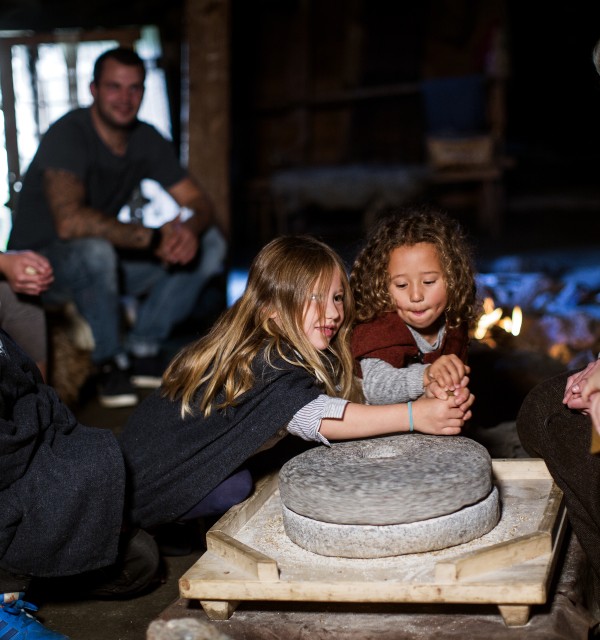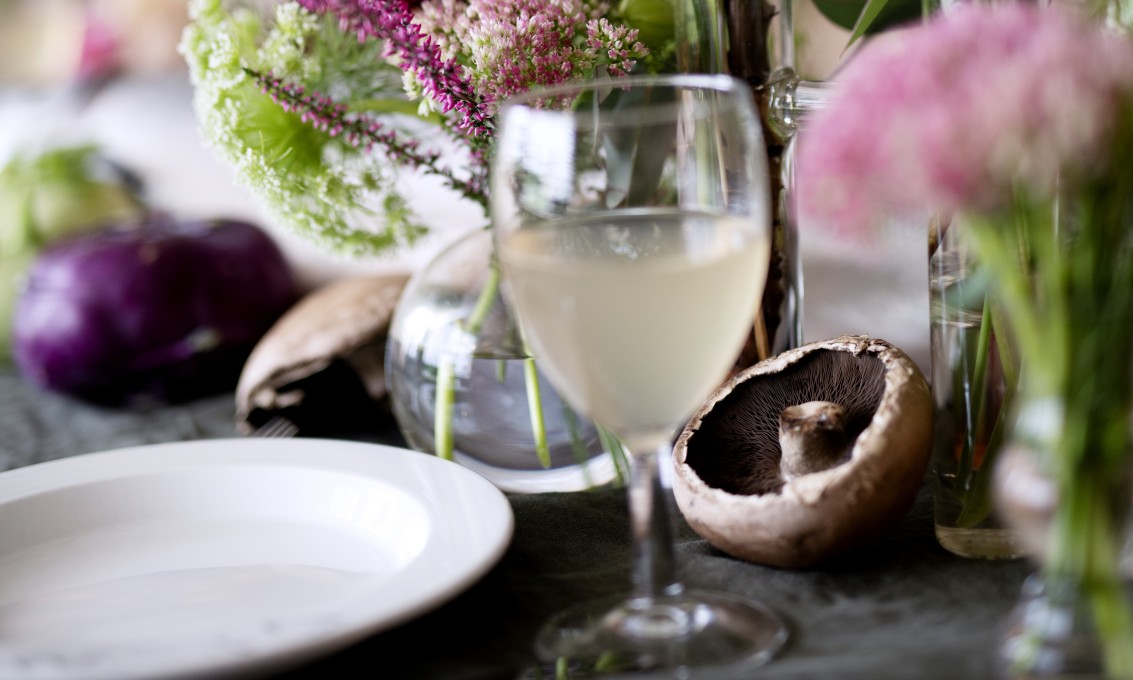Visit the Iron Age Farm at Ullandhaug and experience life in the Late Iron Age. Sit around the open fire and hear stories about everyday life 1500 years ago. As the only one of its kind in Norway, the Iron Age Farm has been rebuilt on the original remains and ruins of a farm that dates back to the Migration Period, approximately 350 – 550 AD.
Open-air museum overlooking Hafrsfjord
The Iron Age Farm is closed during winter, and opens May 2, 2025. From 2 May - 31 August opening hours are: Monday - Sunday: 10:00 - 16:00
Madlamarkveien 152, Stavanger
Tel: 51 83 26 00 E-mail: jernaldergarden@uis.no
The Iron Age Farm is open to booked groups every day of the year. Contact am-booking@uis.no
A visit to the Iron Age Farm is exciting for the whole family.
Activities for the whole family
The Iron Age Farm at Ullandhaug is a living, open-air museum that is open all year round. Open fireplaces provide warmth and atmosphere in the longhouses. Sitting around these open fires gives visitors an intriguing feeling, knowing that a family sat right here 1500 years ago!
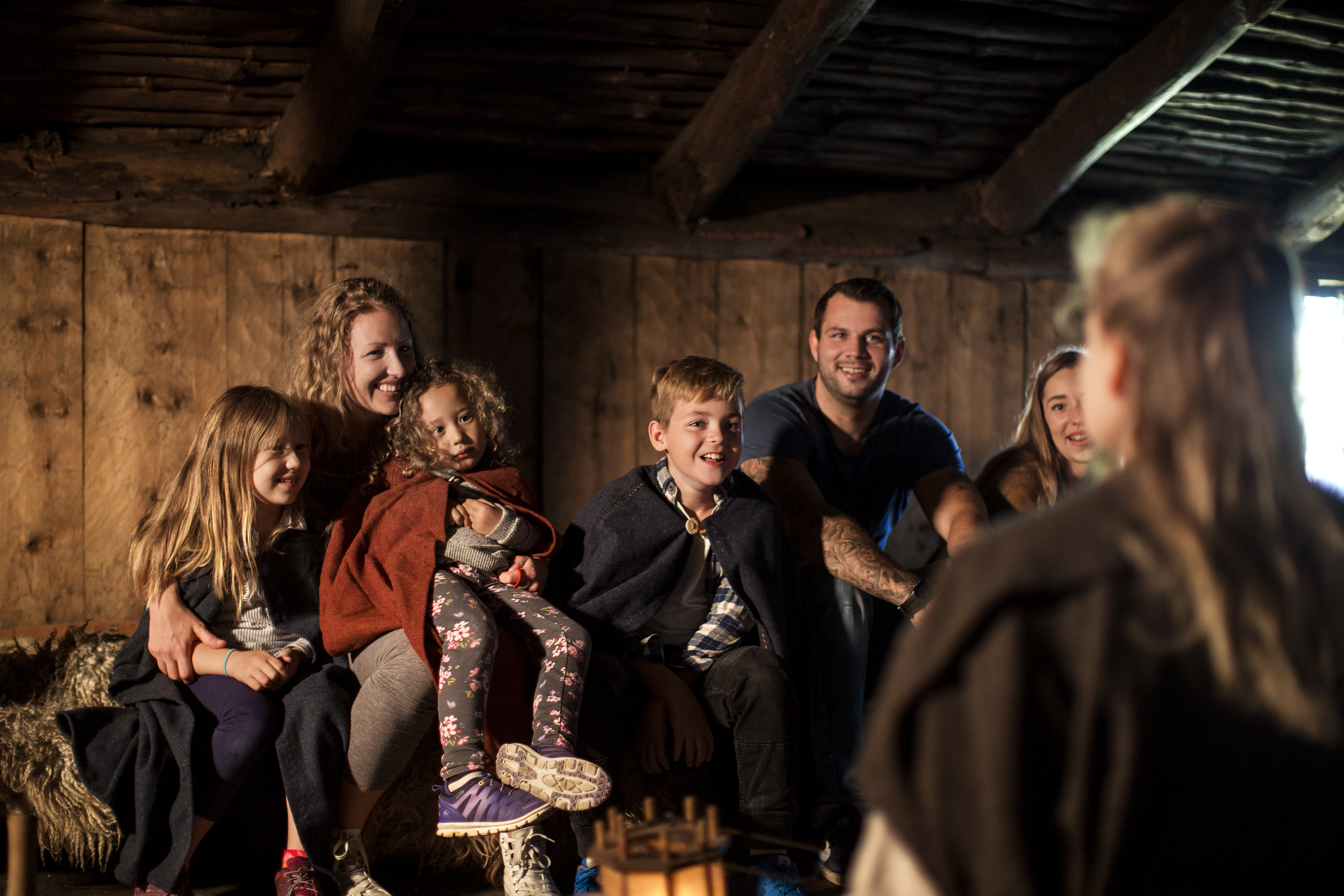
The Iron Age farm at Ullandhaug is a reconstructed farm from the Migration Period, approximately 350 – 550 AD. The farm is located at the top of Ullandhaug, approximately 3 km from Stavanger city centre, with magnificent views of Nord-Jæren and Hafrsfjord. As the only one of its kind in Norway, the Iron Age Farm has been rebuilt on the original remains and ruins of a farm that dates back to the Migration Period. The three houses are furnished with equipment and household utensils, and there are open fires burning in the original fireplaces.
Visitors are greeted by the Lady of the farm and the farm inhabitants. There are tours and activities for the whole family.
Have a look at artefacts found at the farm
At the Iron Age Farm visitor centre, guests can see artefacts that have been found at the farm, and learn more about the excavations that took place in the 1960s.
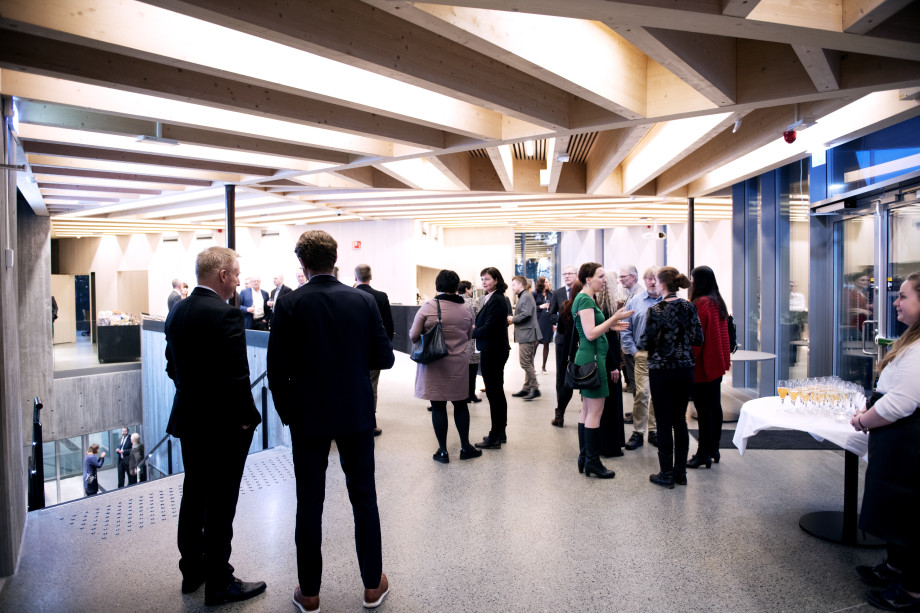
I besøkssenteret er det også to utstillingar. I den eine kan du sjå og lære meir om kva There are also two exhibitions at the visitor centre. At one of these exhibitions, visitors can see and learn more about the archaeological finds that have been made at the farm. The farm consists of three houses.
The artefacts excavated from the original houses at the Iron Age Farm are very similar to the equipment and utensils that were used at other farms from the same period. The most common finds are pieces pottery, totalling over 2500 shards of large and small vessels. Apart from charcoal, burnt birch bark (from the roof), a few burnt bones and burnt hazelnut shells, no organic material has been preserved.
Many fire-cracked stones, shards of clay vessels, an iron knife, whetstones, iron fittings and nails were found in House 1. All six fireplaces were located in the lower half of the house. Many fire-cracked stones were found along the walls, a sign that food was often cooked here. The house may have been a banquet hall that was used on special occasions.
Due to the fact that very few artefacts and no fireplaces were found in the upper part of the house, we believe that the room may have been used as a storage place for animal feed and tools. It may also have been a barn for sheep, pigs and hens.
Clay vessels, a fishing sinker made of stone, parts of a crucible, millstones, flints and burnt bones were found in House 2. Unlike the other two houses, this house only has one room, one fireplace and one entrance. The finds suggest that the house had many functions and housed many activities. The house may have been someone’s dwelling or the house of a retired farmer. It may also have been a place where grain was dried and stored.
Shards of clay vessels, parts of weaving weights, glass beads, spinning wheels, flints, crushing stones, whetstones, a millstone and iron nails were found in House 3. This house is the longest house on the farm and has the most fireplaces and rooms. The upper part was used as a barn. The doorway leads out to an enclosure, which in turn leads to a farm track that took the cows directly from the barn into the fields. The two rooms in the middle of the house were used as living quarters. Here, finds show that the inhabitants made food, spun wool and weaved.
Mapping and excavation
Gardsanlegget vart omtala og kartlagt i 1900 av konservator Tor Helliesen ved The farm was referenced and mapped in 1900 by Tor Helliesen, the curator at Stavanger Museum. This was part of his systematic collection of information on cultural and historical monuments at Nord-Jæren.
It is thanks to Helliesen’s thorough work that we currently have such a complete overview of the farm at Ullandhaug. Unfortunately, many artefacts were subsequently removed from the farm.
In 1967–68, the farm was archaeologically and scientifically surveyed by the archaeologist Bjørn Myhre. At that point in time, it was the largest excavation project that had ever taken place in Rogaland County. Fireplaces, remnants of dividing walls and artefacts that belonged to the people who lived there were found inside the house.
As part of the commemoration of the 1100 year anniversary of the battle of Hafrsfjord, King Olav V officially opened the Iron Age Farm at Ullandhaug in 1972
The Iron Age - an evolving society
The Iron Age Farm is located at the top of Ullandhaug, with magnificent views of Nord-Jæren and Hafrsfjord. People lived here over 1500 years ago, at a time when agriculture, craftsmanship and infrastructure were rapidly developing.

The Migration Period
The Migration Period is the name of a period in the Iron Age that stretches between 350 to 550 AD. As the name suggests, the Migration Period was a time of migration and war. At the same time, agriculture, craftsmanship and societal infrastructure was developing rapidly. Farms were being built in any place where one could create a livelihood, and large seafaring ships made it possible to safely cross the Skagerrak strait over to Denmark.
Especially the Hun and Goth migrations across the European continent in the 4th century gave the period its name. Like the rest of Scandinavia, Norway did not experience such large migrations at this time, but the many hill forts and finds of buried gold in Rogaland County also indicate that this area experienced war and conflict. The many rich burial finds at Jæren and the fact that the Ryger people are mentioned in historical sources from the 6th century may indicate that Rogaland was politically united under one ruler at this time.
The Farmhouses
All the houses had earthen floors and were built of wood with outer stone walls that provided protection against rain and wind. The roofs were most likely made of turf.
The roofs were supported by two parallel rows of pillars that stood inside the house. Pairs of pillars were bound together with a crossbeam so that they formed a timber frame. These types of timber framed houses have been in use in Rogaland right up to the present day.
Fireplaces, remnants of dividing walls, food remains and artefacts that were lost or discarded by those who lived there were found inside the house.
Based on this, we have an idea of how the house was used. House 1 (to the northwest) has been divided into at least two rooms. The upper room was most likely a sheep barn or a storage room. Food remains were found in the lower room. It is believed that this part of the house was used as a banquet hall on special occasions. The smallest house (House 2) was a normal dwelling where the inhabitants made food, carried out handicrafts and maybe repaired tools and equipment. It is possible that an individual group of young or elderly people lived in this house.
The upper part of the longest house (House 3) was used as a barn. The rest of the house seems to have been divided into several rooms. The room closest to the barn was mainly used to cook food and could have been a kitchen and a wash house. The next room was also used to cook food, but there is also evidence that the inhabitants worked with textiles, metalwork and other handicrafts. The lower room in House 3 was most likely used as a storage room. Right at the far end, on the southern short wall, there was an extension that may have housed tools or firewood. This mirrors the extensions that can be found on Jær houses in recent times.
What was cultivated at the Iron Age Farm?
Barley, oats and possibly turnips were grown in the nearby fields. In addition, they ate wild plants such as lady’s thumb, wild buckwheat, lamb’s quarters and chickweed. Flax was also cultivated at this time, probably for its nutritious seeds and as raw material in the production of textiles.
They cultivated the soil with the help of ridging ploughs, spades, forks, hoes and harrows. A ridging plough is a flimsy and light type of plough without a mould board that makes furrows in the soil. The crops were harvested with the help of sickles, scythes, leafing knifes, forks and rakes. These tools haven’t really changed since the Iron Age. Clay vessels, textiles, bronze jewellery and wooden and iron tools were made at the farm. They also carried out stonework such as millstone production.
Not much forest
1500 years ago, there was as little forest at Jæren as there is today. Therefore, Ullandhaug inhabitants had to travel a long way to fetch timber or to go hunting. The sea was closer than it is today, with Hafrsfjord being the nearest harbour. Finds of fishing sinkers in the floors at the Iron Age Farm indicate that fish must have been an important resource.
The farm is burning!
In the middle of the 6th century, the farm burned down and was deserted. We can only guess what actually happened.
A spearhead that was found at one of the houses could suggest that a war had taken place. People may have been killed before the house was set on fire. Another reason may be that the people at Ullandhaug perished during an epidemic. The bubonic plague was sweeping through Europe at this time. The farm may have been burned down in an attempt to eradicate the disease.
The lady of the farm was the one in control
The main farm was the heart of the local community during the Migration Period. The lady of the farm governed her part of the large household.
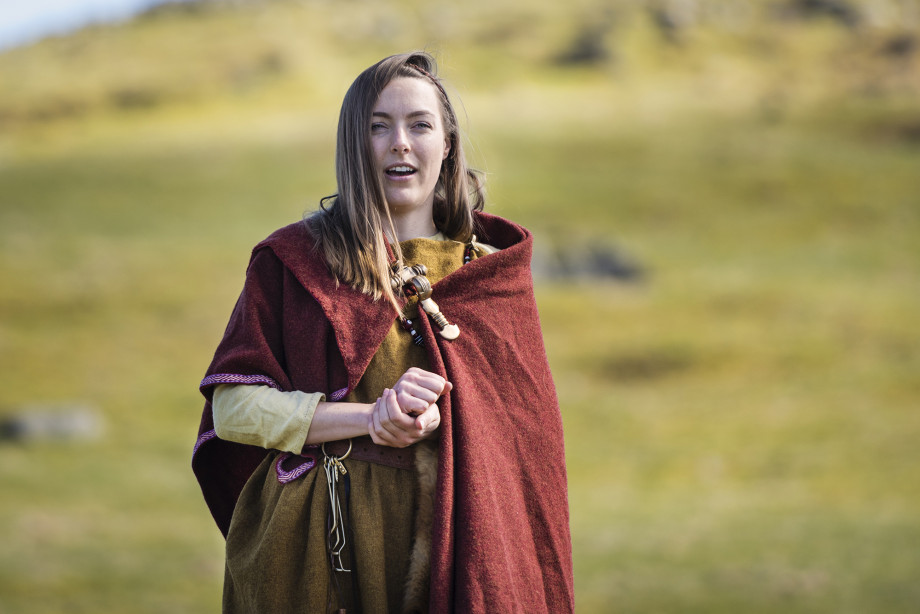
People of the Migration Period looked exactly the same as we do today. They were approximately the same height as we are today, which means that they had a nutritious and varied diet. However, they often suffered from arthritis and osteoarthritis.
Dangerous and infectious diseases such as tuberculosis and the bubonic plague were probably as widespread as they were in later periods. The number of children that died and the average life expectancy seem to have been about the same as 150 years ago. Not many people passed the age of 60.
10 to 12 people lived on the farm
We estimate that 10 to 12 people lived at Ullandhaug. If this was the average number of people living on a farm during the Iron Age, we believe that Flat-Jæren had a population of approximately 3 to 4000 people. This is similar to the population during the 1700s. People wore woven clothes made out of wool, flax, nettle and hemp. The yarn was usually dyed using plants before being woven. Textile handicrafts at this time were very well developed. They often wore capes or cloaks made from wool, leather or fur over their woven clothes. They also wore soft shoes. Some people also walked barefoot.
The lady of the farm held the keys
The lady of the farm also organised all the major meals. Here, everything had to be correct; the family’s honour was at stake. The gods ruled over the harvests and the fate of the family, and the religious feasts had to be carried out so that the gods would be content. The way in which the lady of the farm carried around the drinking cup highlighted the social norms during a meal. The person with the highest rank got to drink from the cup first.
Relief buckles are examples of magnificent gilded silver or bronze jewellery, and they are decorated with animal ornamentations. This style is a Scandinavian form of expression that began on these types of buckles in the 5th century, and can also be seen in stave church portals 800 years later.
The lady of the house held the keys to the farm. Bronze keys had a greater symbolic value than practical value. They were part of the bridal ceremony. After getting married, the woman took on the role of housewife. Sources show that the right to use the keys was a criterion for a legal marriage, and the husband was fined if he took the housewife’s keys. The keys symbolised, and made the housewife responsible for, everything that could be locked away in chests and boxes. They have also been a symbol of the housewife’s real power.
Women were the ones who also controlled all parts of textile production, from the wool to finished garments.
Animal husbandry
Seeing as no animal bones have been found at the farm, we don’t know what kind of animals they had at Ullandhaug. But we know that the following animals were around at the time: The breeds of cattle they had were smaller than those we have today. They had both red-white and grey breeds. The sheep they had were similar to old Norwegian short tailed sheep, a small breed that had long and smooth wool. Their horses were similar to Icelandic horses; small in stature with a special tölt gait.
The pigs were similar to wild boar, black, bristly and had large tusks. These could be very dangerous! The hens were small and speckled. There were mainly two breeds of dog; a type of elkhound and a type of setter. Maybe these were the guard dogs and the hunting dogs of the time? We really don’t know if there were cats, geese or ducks around 1500 years ago.
Today, sheep graze on the Iron Age farm.
The Norse god Ullr and Ullandhaug
What the name Ullandhaug actually means is disputed and rather uncertain. One explanation is that the word derives from the combination of ‘útland’ (outskirts) and ‘haug’ (hill). This might mean ‘a part of the farm that is on the outskirts’, i.e. a farm that belonged to a larger farm, such as Jåttå. A more likely explanation is the name’s connection to the Norse god called Ullr.
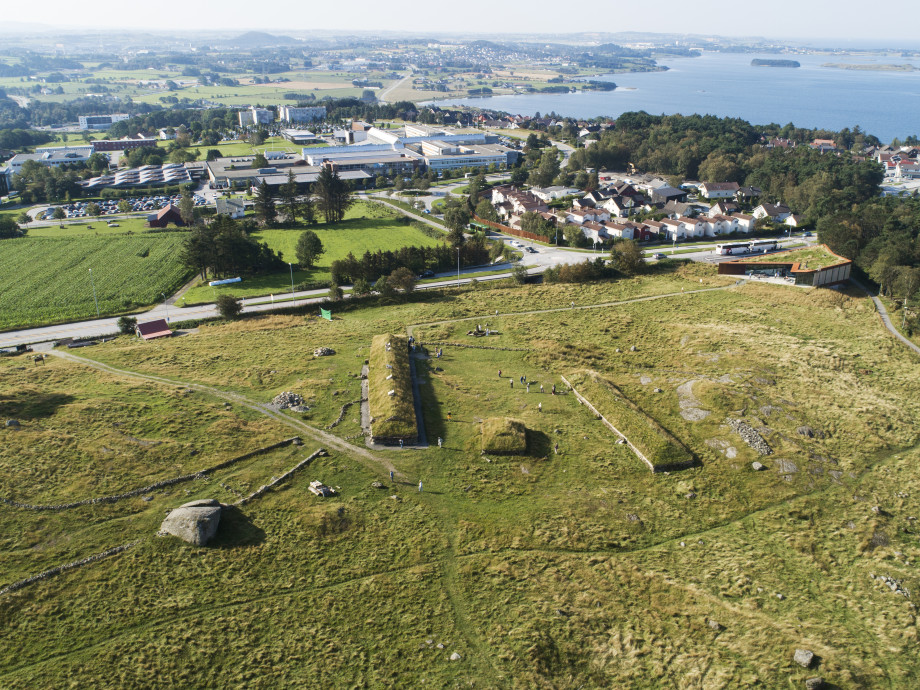
The Norse god Ullr is not mentioned that often in Norse mythology, but place names suggest that he has been the main god in certain parts of Scandinavia at some point. In Norway, one can find Ullensaker, Ullensvang, Ullern, Ullevål and Ullandhaug. One often finds place names that include Ull in Uppsala in Sweden. However, Ull-names are not present in Denmark and Iceland.
Saxo Grammaticus (appoximately 1150–1220 AD) was a Danish author and historian from the Middle Ages. In his saga called Gesta Danorum, he mentions Ollerus (Ullr) who gained control of the country after Odin was exiled. Ollerus ruled for ten years until Odin was called back. The story is reminiscent of an ancient cult of change from Ullr to Odin.
Snorri Sturluson wrote that Ullr is the son of Sif and the stepson of Tor, and was therefore placed on the outskirts of the god family. The name is associated with a Germanic word that means splendour or glory, and it has been speculated that Ullr may have originated from an ancient sky god. Ullr was the god of law and justice, and literary sources mention the swearing of oaths on ‘Ullr’s ring’. Snorri Sturluson goes on to describe Ullr as a skilled skier and archer. Ullr’s home was called Ýdalir (Yew Dales), and yew wood was used to make the best bows.
Latest news from the museum
Bettina Ebert has received eight million NOK to research medieval adhesives
Conservator Bettina Ebert at the Museum of Archaeology has been awarded eight million by the Research Council of Norway....
Exhibit case information for "Fabulous Animals"
From September 2023 until November 2024 you can visit the exhibition "Fabulous Animals" at Museum of Archaeology in Stav...
Discovery of the century – Norwegian gold treasure found with a metal detector
Extraordinary gold find from the 6th century discovered on the island of Rennesøy, Stavanger.
New Viking Period exhibition coming soon
Our new Viking exhibition, focused on myths and stories from the Viking Period, opens Friday 25th of August. The current...
10 million NOK for research on under-explored marine resources
Environmental changes from generation to generation aren’t always visible. A new research project exploring natural reso...
The library at the Museum of Archaeology
The library is open to staff, students, and anyone interested in our fields of study. Our specialist areas are archaeolo...
Unique sword casts new light on Viking voyages across the North Sea
A unique type of Viking Age sword with spectacular ornamentation has been found in Stavanger. The closest parallel is a ...
Jewellery from grave of high status Viking woman delivered at museum’s door
Archaeologists at the Museum of Archaeology in Stavanger could hardly believe their eyes when dress accessories typical ...
Viking beacons - Militarism in northern Europe
The project will investigate beacons or warning fires that were lit during attacks on the country in the Viking Age and ...
Explore the prehistory in our exhibitions
At the Museum of Archaeology, you meet the past in new and modern exhibitions. Here you get the story of all those who h...
Welcome to Café Ask and Embla: Flavours from the pre-history
Welcome to Café Ask and Embla, a delightful culinary destination at the Museum of Archaeology and the Iron Age Farm.
About the Museum of Archaeology
The Museum of Archaeology at UiS conducts research, administration and dissemination regarding human beings and their en...
PhD Programme in Social Sciences
The PhD programme in Social Sciences at the University of Stavanger is divided into five research schools: Research Scho...
